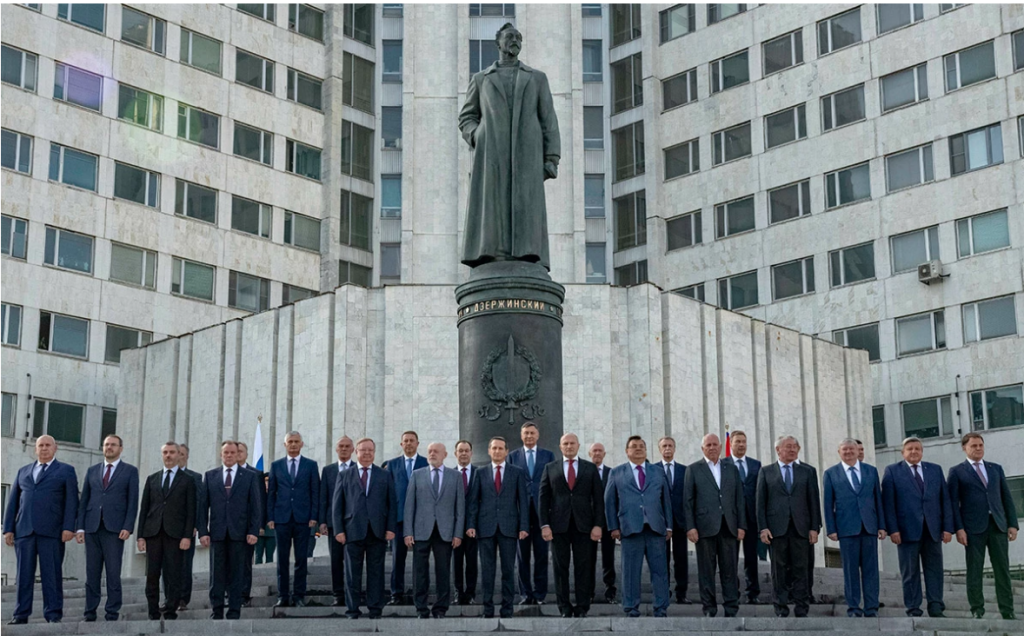The Jordan Center stands with all the people of Ukraine, Russia, and the rest of the world who oppose the Russian invasion of Ukraine. See our statement here.
Mikhail Svirin is a graduate student in history at Miami University. His research interests include Soviet and post-Soviet subjectivity, collective memory, education, and social changes.
Above: Officials pose with the Dzerzhinsky statue in front of the SVR compound, 11 September 2023.
Since 24 February 2022, political repressions in Putin’s Russia have intensified. In addition, the Kremlin has engaged in an intense battle with and for symbols. New monuments, new textbooks, and an obsession with collective memory reveal history as another crucial battlefront against civil society and what Russian authorities call the “West.”
On 11 September 2023, Sergey Naryshkin, the longtime head of the Foreign Intelligence Service (SVR), unveiled a bronze statue of Felix Dzerzhinsky outside SVR headquarters in Moscow. This ceremonial opening could more accurately be called a re-opening, since the statue’s original had once stood in the very center of the capital, on Lubyanka Square. Erected in 1958, it was positioned directly in front of the notorious Lubyanka, the headquarters of the KGB.
Felix Dzerzhinsky (1877-1926) is known as the architect of the Red Terror (1918-1922), a merciless campaign against those considered enemies of the Bolshevik Revolution. During the Soviet period, he was officially regarded as the founding father of the secret police, initially called the Cheka, and as a defender of state security from external and internal “enemies.” For many in Soviet society, he was the personification of state terror.
After the failed August 1991 coup against Mikhail Gorbachev, when Soviet authorities had already lost their hold on power, activists vandalized the statue of Dzerzhinsky and tried to destroy it. Footage from the scene became a powerful symbol of a newly independent Russia. Ordinary Soviet citizens chose to attack Dzerzhinsky in August 1991 because his statue represented the state’s repression from 1917 onward. Later, the Moscow city administration opted to remove the statue, expelling it to the Park of the Fallen Heroes (known after 1992 as the Muzeon Park of Arts). Dzerzhinsky’s Cheka and its descendants, including the NKVD under Stalin and the KGB from 1954 on, were seemingly consigned to the dustbin of history.
Given the rage that citizens back in 1991 had directed against Dzerzhinsky and his secret police, what accounts for his return to the scene today? What are SVR director Sergey Naryshkin and his colleagues saying to Russian society? What is their message to the world?
The symbolic rehabilitation of Dzerzhinsky was a gradual process. In 2007, the statue was awarded “regional significance” status. In 2015, the words “antichrist,” “executioner,” and other graffiti were removed as a part of a “restoration.” In 2021, the Moscow Prosecutor's Office recognized the removal of the statue in 1991 as illegal.
Since the 1990s, there have been several unsuccessful attempts to return the statue to Lubyanka Square. Until very recently, fears of causing a societal divide outweighed the authorities’ desire to restore the Soviet past. However, since the invasion of Ukraine, the Putinist state has explicitly divided society into “enemies of the Motherland” and its “defenders,” thereby literally reproducing Soviet discourse. This new configuration of power provoked a shift in the status quo around the Dzerzhinsky monument.
The return of Dzerzhinsky is a symbolic restoration of the USSR, the cancellation of the notorious “geopolitical catastrophe” Putin described in his 2005 speech. The Kremlin has come to view the 1991 demolition of Dzerzhinsky as an uncontrolled act, a sign of state weakness, and a betrayal from society. Accordingly, the return of the statue is both an act of revenge and a demonstration of renewed power.
However, the statue Naryshkin unveiled on 11 September is only a copy of a Soviet original, which still stands in the Muzeon. In addition, the restoration of Dzerzhinsky in peripheral Yasenevo, where the SVR headquarters is located, instead of the central Lubyanka could be read as a symbolic downgrade—so we might expect the original to resurface on Lubyanka Square sometime soon. The new statue has one advantage over the old one: it is uncompromised, having never been defaced with graffiti or allowed itself to be toppled. Yet the proliferation of copies suggests that Russian authorities have no new symbols to offer and can only repeat old ones.
At the same time, the new statue implies a new representation of those who opposed Dzerzhinsky. In this story, monuments, which by definition have a commemorative function, are erected not to the victims, but to their murderers. This anti-memorial message is also confirmed by the recent closure of organizations such as Memorial International, which, since 1987, has worked on commemorating victims of Soviet repression. The recuperation of Dzerzhinsky symbolically absolves the state of responsibility for Soviet-era terror while presenting violent repression as fair policy against perceived “enemies” today.
The return of the past in Putin’s Russia resembles a mass-scale historical reenactment. The revived Dzerzhinsky again looks to the West—toward Poland and the Baltics—while the gentlemen who proclaimed themselves his successors proudly pose with the reanimated founder of Soviet terror in the background.



